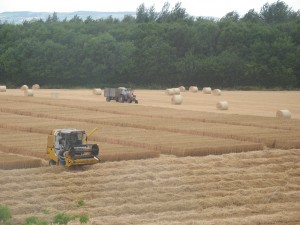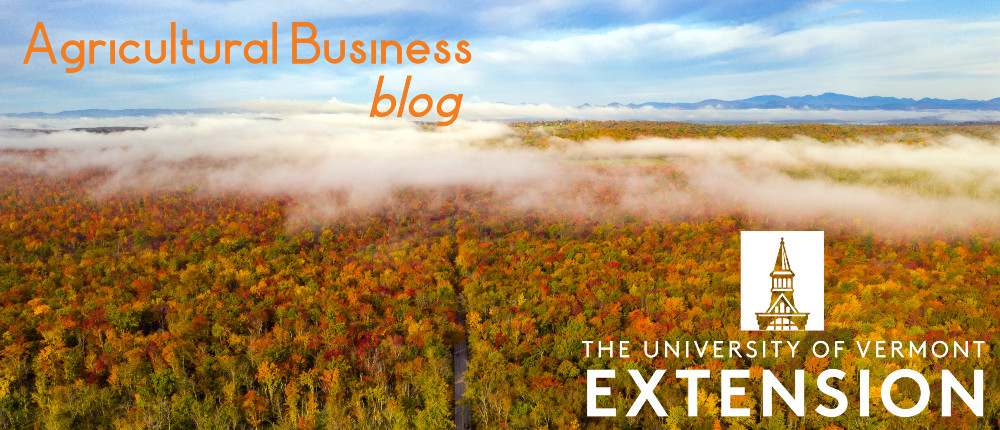Ireland today, 25 July, 2013.
The last two-and-a-half weeks were declared a drought here in Ireland. There was no rain, and temperatures were up in the 80s. Hayfields that had been cut were not showing any regrowth, lawns were drying up. Winter barley was ready for harvest a little ahead of schedule. Pastures had stopped growing so some dairy farmers were beginning to feed haylage that they had just made a few weeks before. Towns were running low on water- lower pressure at nights, and warnings to not be watering lawns, washing cars, or filling wading pools. I saw one tractor with a wagon and a 4 foot poly cube of water, and livestock farmers were beginning to shift to their secondary water supplies.

Big windrow of late cut hay, County Carlow.
Farmers are making more dry hay this year than they have in years.
Drought is not a usual problem here in Ireland. But, even as I am writing this, a little thundershower is brightening people’s moods as some moisture returns. Today’s paper even has a blight warning for potato growers, as there is likely to be a few days of wet leaves, that would promote late blight on the spuds. Last night there were scattered showers, folks are hoping for a good rain!

Winter barley harvest begins, Teagasc Oak Park, Ireland
The grain harvest has begun. Here is a photo of winter barley trials being harvested at the Teagasc Oak Park center.
About Ireland.
Ireland is about the size of Maine, or about three times the size of Vermont.
The population is about 4.5 million in the Republic of Ireland (26 counties). With Dublin, the capital having about 1.1 million people in the city limits. Cork is the second largest city in the Republic, with just under 200,000. Northern Ireland has about 1.8 million people. (6 counties, part of Great Britain, Scotland is another part of Great Britain). Belfast is the largest city in the north, with 278,000 people. So, all together, there are 6.3 million people on this island. This is roughly the population of Tennessee. Or about 10 times the population of Vermont.
So, if the area is 3 times the size of Vermont, and it has 10 times the population, it is more densely populated than Vermont. And yes it is. Dublin is a big city, with lots of people packed in there. But, there is a lot of open land, a lot of farm land, and back roads with not too many houses on them. Plus there is mountainous territory and bog that don’t have anybody living there.
Vermont is roughly 80% forested, and Ireland is 10-15% forested. Ireland had been mostly forest, then the forests were cut. Oak went into British ships, cathedrals, and barrels. Now there have been European Union programs to pay land owners to plant both softwood and hardwood trees and to maintain the plantations. Softwoods like Douglas Fir, and hardwoods like ash and beech. Thinnings from these forests are used for fuel, and they use or sell the lumber. A friend has been thinning his ash, and figures he has enough wood in a shed to last for 5 years or so!
A first look at Irish farms.
| |
Ireland 2010
|
US 2007
|
VT 2007
|
| Number farms |
140,000
|
2.2 million
|
6,900
|
| Average size |
81 A
|
418 A
|
177
|
|
Farm types
|
|
|
| Beef |
55%
|
36%
|
28%
|
| Dairy |
11%
|
3%
|
18%
|
| Mixed livestock |
11%
|
|
|
| Other crops+hay |
5%
|
20%
|
44%
|
| Grain |
5%
|
22%
|
3%
|
Ireland. In 2010, the census counted just about 140,000 farms, with an average farm size of 81 acres. More than half the farms had beef animals. About 11% of the farms had dairy cows. About 11% had a mix of livestock, like dairy and sheep or dairy and beef. About 5% of the farms had hay and another crop- maybe barley or wheat. And another 5% had just grain.
In the US in 2007, the census counted 2.2 million farms, with an average size of 418 acres. Over a third of the farms had beef animals. Just under a quarter of the farms had grain. Twenty percent had hay and other crops, and only 3% of the farms had dairy cattle.
In Vermont in 2007, the census counted 6,900 farms. Over a quarter had beef cattle. Just under 20% had dairy cattle. Only 3% had grain, mostly corn. And 44% had hay or another crop.
More next week!



